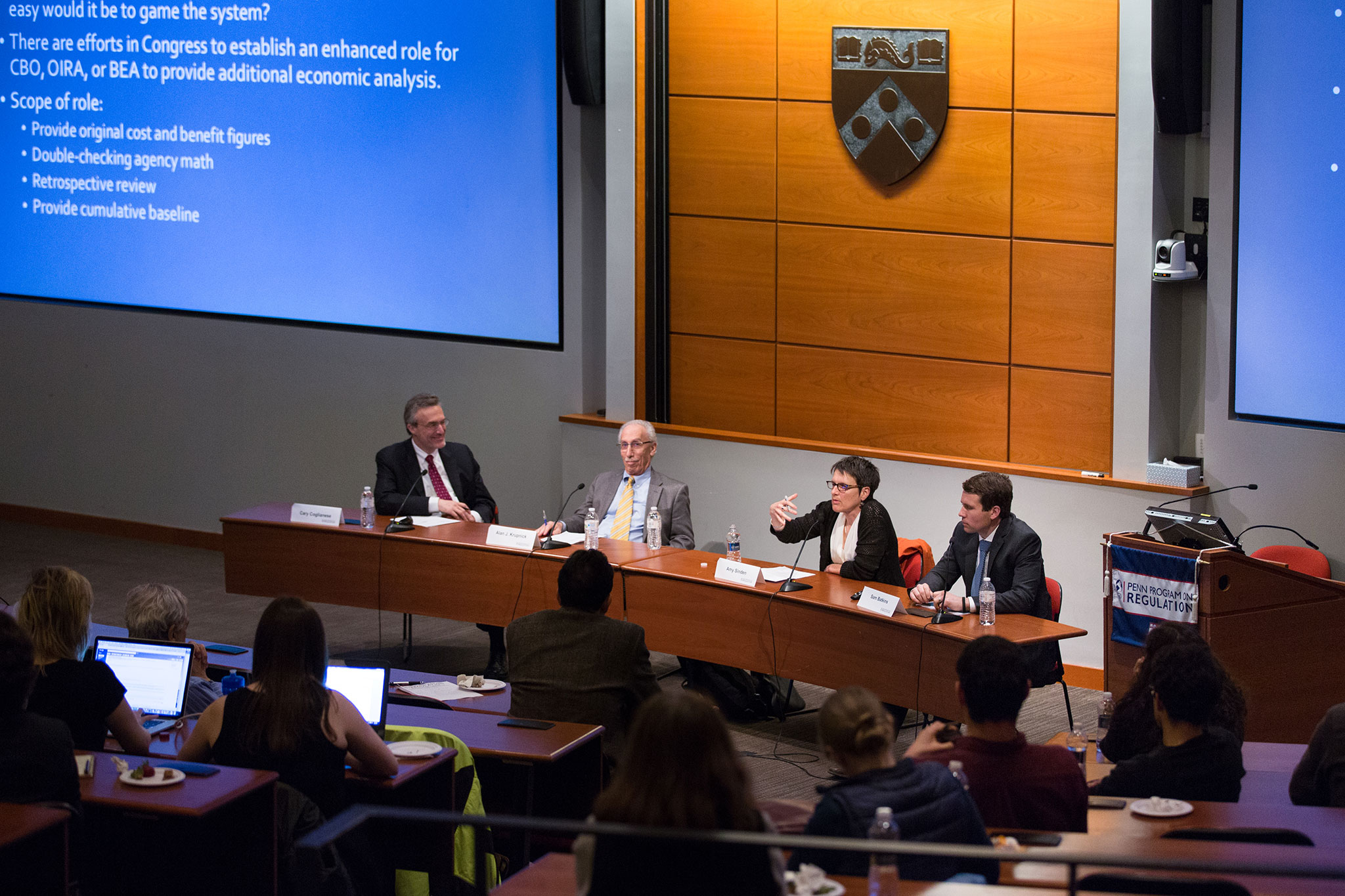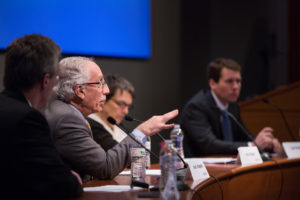
PPR panel discussion analyzes the Trump Administration’s regulatory goals and its likelihood of achieving them.
“We’re going to be cutting regulation massively…we think we can cut regulations by 75 percent, maybe more,” President Donald J. Trump said shortly after his inauguration. But is it possible—or even desirable—to decrease the number of regulations to such an extent?
A panel held earlier this year at the University of Pennsylvania Law School examined this question in light of the Trump Administration’s steps to reduce regulations. Cary Coglianese—a professor at the University of Pennsylvania Law School and the director of the Penn Program on Regulation—moderated the discussion and summarized the contours of the Trump Administration’s plans.
Much of the panel discussion centered on the feasibility of President Trump’s “one-in-two-out” policy contained in Executive Order 13,771. That order requires agencies to rescind two old rules for every new significant rule they issue. The total cost of the new rule must be less than or equal to the cost of the old rescinded rules.
Due to rule repeals that have already occurred, some regulators—such as the U.S. Department of Health and Human Services—will likely achieve this net-zero cost requirement, according to panelist Sam Batkins, the then-director of regulatory policy at the American Action Forum. But for most regulatory agencies, to develop a new regulation will now require the full re-evaluation of how well existing regulations achieve their goals and at what cost. Such retrospective review will play an important role in identifying which regulations should be rescinded, according to Batkins.
 Another panelist—Alan J. Krupnick, a senior fellow and co-director of the Resources for the Future Center for Energy and Climate Economics—noted that the Trump Administration’s approach to reducing regulation assumed that retrospective review would identify a lot of inefficient processes that could be streamlined without forgoing any associated benefits. But currently, he said, agencies have insufficient evidence supporting this assumption. Krupnick said that, more worryingly, the executive order does not require agencies to take into account any foregone benefits from the rules they are rescinding, only the costs.
Another panelist—Alan J. Krupnick, a senior fellow and co-director of the Resources for the Future Center for Energy and Climate Economics—noted that the Trump Administration’s approach to reducing regulation assumed that retrospective review would identify a lot of inefficient processes that could be streamlined without forgoing any associated benefits. But currently, he said, agencies have insufficient evidence supporting this assumption. Krupnick said that, more worryingly, the executive order does not require agencies to take into account any foregone benefits from the rules they are rescinding, only the costs.
Panel members agreed that in order to get rid of old rules, agencies still must follow normal rulemaking procedures and build an administrative record that justifies the elimination of existing regulations, The one-in-two-out plan will thus increase the time and expense of creating new rules, as regulators must not only provide reasons and evidence before issuing their new regulations—but now they also must marshal forth evidence to justify rescinding offsetting old ones.
Complying with the one-in-two-out policy might bring agencies into conflict with their governing statutes. Amy Sinden—a professor at Temple University Beasley School of Law—noted that many agencies must consider certain factors prescribed by statutes when issuing or rescinding rules which must be followed. By adding a requirement to eliminate old rules, the President was improperly imposing additional criteria on regulators in violation of existing laws, she argued.
Batkins remarked that the process for issuing or rescinding rules takes time. It requires public notice and comment—where citizens and organizations submit suggestions, opinions, and evidence to agencies about the impact of proposed rules. Litigation can also ensue once an agency rescinds a rule, which could further stall implementation of new rules or rescission of old ones by several years.
But Sinden argued that the Trump Administration’s agencies have sometimes ignored these requirements. For example, the U.S. Environmental Protection Agency delayed the final implementation date of some rules without going through the notice-and-comment process, she said.
More fundamentally, Sinden expressed concern that the President seemed to believe that he could use executive orders to change or rescind regulations without going through agencies or the rulemaking process at all. As Coglianese noted, executive orders can merely instruct agencies to work towards eliminating a regulation; they cannot directly rescind regulations.
Moreover, the President’s one-in-two-out order’s focus on evaluating the costs of rules—without considering their benefits—could be legally problematic, according to Sinden, because many laws require agencies to consider the benefits of rules as well as the costs.
Krupnick acknowledged that the executive order did not necessarily prevent agencies from considering foregone benefits of rules being eliminated, but said it was “completely wrongheaded” for the executive order not to require agencies to take lost benefits into account. He warned that failure to consider both the benefits and the costs of existing rules before rescinding them could lead to the repeal of rules that, on balance, benefited society.
Sinden further noted that regulations often seek to protect necessities—like breathable air and potable water—and that many regulations are expressly designed to shift the costs of industrial activities, like pollution, from the public back onto the businesses that created the problem. Eliminating these rules would yield cost savings but only at the loss of the benefits they deliver, she observed.
Coglianese concluded by noting that it can take agencies a couple of years to develop a new rulemaking—or to build the case for eliminating an existing rule—so it is probably still too early to tell how the Trump Administration will shape regulation in the long run.
The panel discussion was co-sponsored by the Penn Program on Regulation and the Wharton Risk Management and Decision Processes Center.



